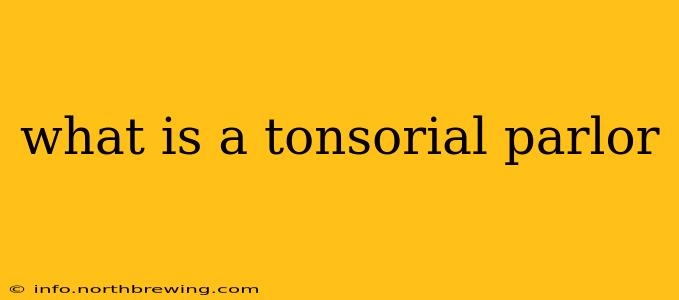The term "tonsorial parlor" might sound a bit antiquated, conjuring images of old-fashioned barber poles and straight razors. And you'd be right! It's a more formal and historical term for what we now commonly call a barber shop or barbershop. But understanding the etymology and evolution of this term helps us appreciate the rich history and ongoing relevance of this vital community space.
What Does "Tonsorial" Mean?
The word "tonsorial" comes from the Latin word "tonsor," meaning "barber." Therefore, a tonsorial parlor literally translates to a "barber's shop" or a place where hair is cut and styled. The use of "parlor" adds a sense of elegance and sophistication, suggesting a more refined establishment than the perhaps more casual term "barber shop."
The History of Tonsorial Parlors
Tonsorial parlors, or barbershops, have existed for centuries, evolving alongside societal trends and technological advancements. Historically, barbers played a multifaceted role in society. Beyond hair cutting, they often performed other services such as:
- Surgery: Before the development of specialized medical practices, barbers often performed minor surgeries like bloodletting. The iconic red and white barber pole symbolizes this historical connection; the red stripes represented blood, and the white stripes represented bandages.
- Dentistry: Similarly, barbers sometimes undertook rudimentary dentistry.
- Social Gathering Places: Barbershops have always been social hubs, providing a space for men to connect, share news, and engage in lively conversations.
The image of the tonsorial parlor shifted throughout the 20th century. The rise of specialized medical professionals led to the separation of barbering from surgical and dental practices. However, the barbershop's role as a social gathering place remained, and continues to this day.
What's the Difference Between a Tonsorial Parlor and a Barber Shop?
Essentially, there's no functional difference. "Tonsorial parlor" is a more formal and historically accurate term, while "barber shop" (or "barbershop") is the common modern usage. You're unlikely to find a business explicitly calling itself a "tonsorial parlor" today, though the term might be used in historical contexts or by businesses aiming for a vintage or sophisticated aesthetic.
Are Tonsorial Parlors Still Relevant Today?
Absolutely! While the term itself might seem dated, the services provided remain highly relevant. Modern barbershops often offer a wide range of services beyond basic haircuts, including:
- Hair styling and treatments: From classic cuts to trendy styles, barbers cater to diverse preferences.
- Shaving services: From traditional wet shaves to modern techniques, barbers provide expert shaving services.
- Beard trimming and styling: Beard care is a significant part of modern barbering.
- Hair coloring and treatments: Many barbershops offer hair coloring and other treatments to enhance hair health and appearance.
The social aspect of the barbershop remains crucial. It’s a place for community, conversation, and connection, continuing its legacy as a vital social space for men.
What Services Do Modern Barbershops Offer?
Modern barbershops offer a wide range of services tailored to meet the diverse needs of their clientele. This goes beyond the traditional haircut to include:
- Specialized cuts and styles: Barbers are skilled in various haircutting techniques and styles, catering to different hair types and preferences.
- Shaving and beard grooming: From classic hot towel shaves to beard trims and shaping, barbers provide expert grooming services.
- Hair products and advice: Many barbershops offer a selection of hair products and provide personalized advice on hair care.
- Additional services: Some barbershops expand their services to include hair coloring, scalp treatments, and even facials.
In conclusion, while "tonsorial parlor" might evoke a sense of nostalgia, the essence of this establishment remains alive and well in today's modern barbershops. They are more than just places to get a haircut; they're vital community hubs offering a range of services and a space for connection and conversation.
